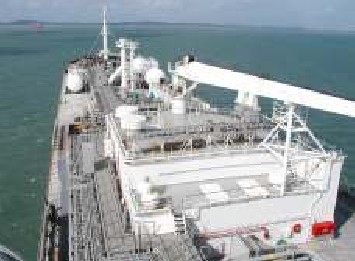Fig:Fully refrigerated LPG carrier at sea
Cargo capacity
The ships are typically in the range 15,000 m3 – 85,000 m3, with three common sizes for LPG/Ammonia trades of 30,000 m3, 52,000 m3 and 80,000m3.
Temperature control
The trend for longer voyages has imposed a demand larger ships, and with the increasing size of the ship, the pumping and refrigeration plant capacity has increased proportionally.
Construction
The tanks nearly extend to the full width of the ship, with ballast in the double bottom and upper hopper or wing tanks. These tanks normally have a centreline bulkhead fitted with two equalizing valves. You should be cautious should these vessels develop a list alongside as the tanks carry a large free surface area and if the vessel has problems with the ballast or levelling the cargo during load they can quickly list over to 2 or 3°.
Type 'A' tanks
Type 'A' tanks are constructed primarily of flat surfaces. The maximum allowable tank design pressure in the vapour space for this type of system is 0.7 barg; this means cargoes must be carried in a fully refrigerated condition at or near atmospheric pressure (normally below 0.25 barg).
Figure shows a section through this type of tank as found on a fully refrigerated LPG carrier. This is a self-supporting prismatic tank which requires conventional internal stiffening. The tank is surrounded by a skin of foam insulation. Where perlite insulation is used, it would be found filling the whole of the hold space.
The material used for Type 'A' tanks is not crack propagation resistant. Therefore, in order to ensure safety, in the unlikely event of cargo tank leakage, a secondary containment system is required. This secondary containment system is known as a secondary barrier and is a feature of all tankers with Type 'A' tanks capable of carrying cargoes below -10°C.
For a fully refrigerated LPG carrier (which will not carry cargoes below -55°C) the secondary barrier must be a complete barrier capable of containing the whole tank volume at a defined angle of heel and may form part of the tanker's hull, as shown in the figure.
In general, it is this design approach which is adopted. By this means appropriate parts of the tanker's hull are constructed of special steel capable of withstanding low temperatures. The alternative is to build a separate secondary barrier around each cargo tank.
The IGC Code stipulates that a secondary barrier must be able to contain tank leakage for a period of 15 days. On such tankers, the space between the cargo tank (sometimes referred to as the primary barrier) and the secondary barrier is known as the hold space. When flammable cargoes are being carried, these spaces must be filled with inert gas to prevent a flammable atmosphere being created in the event of primary barrier leakage.

Fig:Fully refrigerated gas carrier underway
Related Information:
- Thermal insulation fitted to refrigerated cargo tanks
- Carrying by ethylene carriers
- Carrying liquefied gases by semi pressurized ships
- Carrying liquefied gases by fully pressurized ships
Transporting liquefied natural gases by LNG ships
Liquefied gas carrier safety training
Benifits of compressed gas technology
Compressed gas liquid carriers (CGLC)
Development and potential of todays emerging gas technologies
Transporting economically viable compressed gas liquids from remote fields Benifits of compressed gas technology
Increased cargo capacity for LNG ships & advantages of the dual fuel diesel electric propulsion
Transporting liquefied natural gases by LNG ships
Gas cargo containment systems - primary barrier (the cargo tank),secondary barrier, thermal insulation and more
// Home page/// LNG handling /// LPG handling/// Sea transport /// Gas products///
Cargo work ///Fire precautions ///Health hazards ///Safety Precautions
///Emergency response ///
Copyright © Liquefied Gas Carrie.com All rights reserved.
The content published in this website are for general reference only. We have endeavoured to make the information as accurate as possible but cannot take responsibility for any errors. For latest information please visit www.imo.org . Any suggestions, please Contact us !
///Links &Resources // Terms of use/// Privacy policy///Home page///